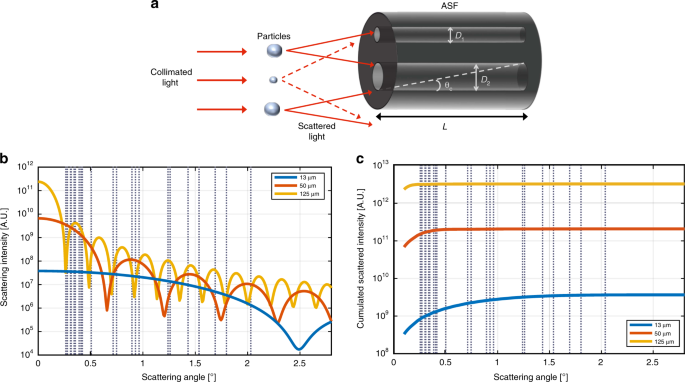Enhance Your Fiber Optic Projects With a Reliable Size Analyser
The combination of a reliable diameter analyser into fibre optic tasks serves as an essential aspect in achieving precision and uniformity. By assisting in precise diameter measurements, these analysers not only enhance the top quality of setups but likewise reduce potential compatibility concerns among components.
Relevance of Diameter Dimension
Measuring the diameter of fibre optic cable televisions is a critical task that makes certain optimum efficiency and reliability in communication systems. Accurate diameter measurement is vital for different reasons, mainly for preserving signal stability and lessening loss. A cable television's diameter straight influences its capability to transfer light efficiently; variances from the defined diameter can result in enhanced attenuation, which influences the total efficiency of the network.
Moreover, exact dimension is critical throughout the setup and maintenance of fibre optic systems. An improper fit in between cables and ports can result in signal degradation or total failing of communication web links. By making certain that sizes are within specified tolerances, specialists can enhance compatibility in between parts, causing improved system integrity.
In enhancement, diameter dimension plays a substantial role in quality control throughout production. Uniformity in the diameter of fiber optic cable televisions is vital for making certain uniform performance throughout different batches. optical fibre diameter analyser. This consistency assists manufacturers maintain industry requirements and cultivates self-confidence amongst end-users
Functions of an Effective Analyser
An effective analyser for fiber optic jobs need to incorporate numerous key attributes that enhance precision and usability in diameter measurement. High-resolution optical sensing units are vital for precise diameter readings, making it possible for users to find also the tiniest variants in fibre thickness. These sensing units should be matched by innovative calibration systems, ensuring constant performance across various conditions and products.
Second of all, an user-friendly user interface is important for helping with convenience of operation. This includes user-friendly software application that permits seamless data input and outcome, in addition to graphes of the dimensions taken. A mobile design improves functionality in different area settings, making it easier to conduct assessments on-site.
Additionally, the analyser needs to sustain several measurement modes, fitting different fiber types and applications. The capability to store and get historic information is another important feature, allowing users to track performance over time and make informed decisions.
Benefits for Fibre Optic Projects
Executing a diameter analyser in fiber optic jobs uses considerable benefits that substantially improve job efficiency and quality. Among the main benefits is the capability to make sure exact measurements of fibre size, which is vital for maintaining optimal efficiency in fiber optic systems. Accurate diameter analyses help in the identification of variances that might lead to indicate degradation or loss, therefore making certain high-grade transmission.
In addition, making use of a diameter analyser simplifies the quality assurance process. By automating measurement tasks, task groups can lower the time spent on hands-on assessments, causing faster project conclusion and lowered work expenses. This performance additionally allows for more strenuous screening protocols, leading to improved product dependability.
Furthermore, uniformity in fiber diameter dimensions promotes compatibility with various other fibre optic components, decreasing the risk of setup mistakes and improving general system efficiency. The incorporation of a size analyser not only help in preserving sector standards yet also cultivates confidence in job deliverables.
Assimilation Into Existing Process
Incorporating a size analyser right into existing operations can significantly improve the functional performance of fiber optic jobs. By effortlessly integrating this modern technology, groups can achieve accurate dimensions that are essential to preserving the honesty and performance of fiber optic systems. This assimilation allows for real-time data collection and analysis, which can be crucial throughout the production and setup this page stages.
Moreover, the capability to automate size dimension processes minimizes the possibility for human mistake, guaranteeing constant high quality control throughout the job lifecycle. The data generated can be quickly shared across platforms, assisting in collaboration among engineers, professionals, and project supervisors. This access boosts decision-making and accelerates project timelines.
Selecting the Right Size Analyser
When picking a diameter analyser for fibre optic projects, it is important to take into consideration a number of key aspects that directly influence measurement precision and operational efficiency. Initially, the resolution and precision of the analyser should line up with the specific needs of your job. Greater resolution instruments can find minute variations in diameter, which is important for ensuring optimal performance in fibre optic systems.
For tasks with tight due dates, a size analyser that provides fast data acquisition can significantly improve productivity. Additionally, think about the analyser's compatibility with existing systems and software application.
Another important factor is the range of diameters the analyser can fit. By very carefully evaluating these factors, you can pick a size analyser that boosts the efficiency and precision my link of your fiber optic projects.
Conclusion
To conclude, the combination of an efficient size analyser is critical for enhancing fiber optic projects. Precise size dimensions make certain optimal performance and reliability while lessening installation mistakes. Advanced features promote real-time data collection and conformity with industry requirements, ultimately raising the top quality of deliverables. By focusing on the choice and implementation of a proper analyser, project performance is substantially improved, paving the method for effective outcomes in fiber optic applications.
A cable's size directly affects its capacity to transfer light efficiently; deviations from the defined diameter can lead Continue to enhanced depletion, which influences the general performance of the network.
